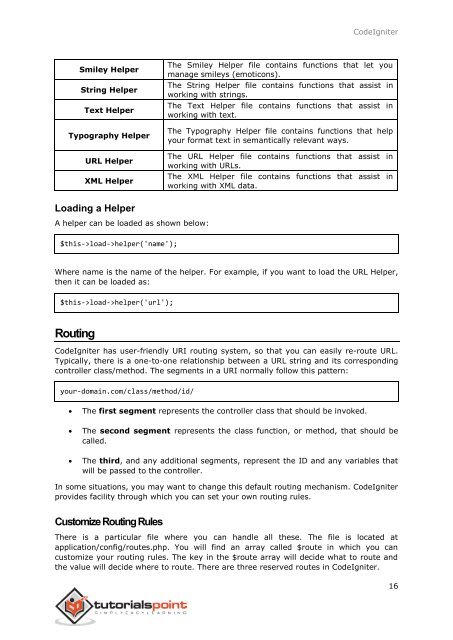codeigniter_tutorial
You also want an ePaper? Increase the reach of your titles
YUMPU automatically turns print PDFs into web optimized ePapers that Google loves.
CodeIgniter<br />
Smiley Helper<br />
String Helper<br />
Text Helper<br />
Typography Helper<br />
URL Helper<br />
XML Helper<br />
The Smiley Helper file contains functions that let you<br />
manage smileys (emoticons).<br />
The String Helper file contains functions that assist in<br />
working with strings.<br />
The Text Helper file contains functions that assist in<br />
working with text.<br />
The Typography Helper file contains functions that help<br />
your format text in semantically relevant ways.<br />
The URL Helper file contains functions that assist in<br />
working with URLs.<br />
The XML Helper file contains functions that assist in<br />
working with XML data.<br />
Loading a Helper<br />
A helper can be loaded as shown below:<br />
$this->load->helper('name');<br />
Where name is the name of the helper. For example, if you want to load the URL Helper,<br />
then it can be loaded as:<br />
$this->load->helper('url');<br />
Routing<br />
CodeIgniter has user-friendly URI routing system, so that you can easily re-route URL.<br />
Typically, there is a one-to-one relationship between a URL string and its corresponding<br />
controller class/method. The segments in a URI normally follow this pattern:<br />
your-domain.com/class/method/id/<br />
<br />
<br />
<br />
The first segment represents the controller class that should be invoked.<br />
The second segment represents the class function, or method, that should be<br />
called.<br />
The third, and any additional segments, represent the ID and any variables that<br />
will be passed to the controller.<br />
In some situations, you may want to change this default routing mechanism. CodeIgniter<br />
provides facility through which you can set your own routing rules.<br />
Customize Routing Rules<br />
There is a particular file where you can handle all these. The file is located at<br />
application/config/routes.php. You will find an array called $route in which you can<br />
customize your routing rules. The key in the $route array will decide what to route and<br />
the value will decide where to route. There are three reserved routes in CodeIgniter.<br />
16




